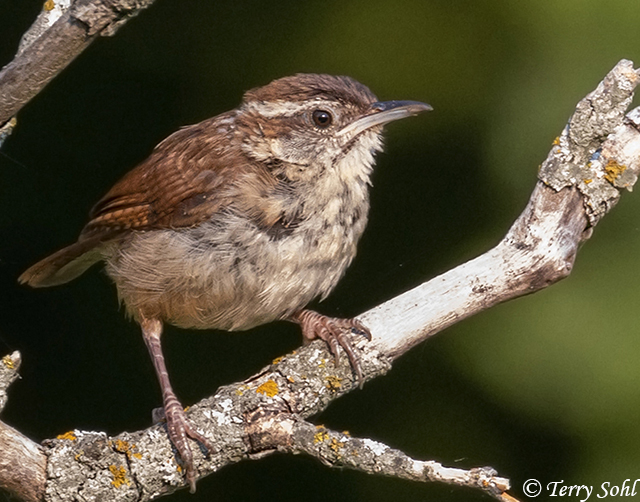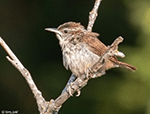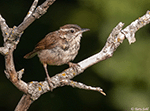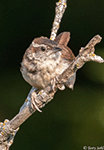Carolina Wren
Thryothorus ludovicianus
| Length: 5.5 inches | Wingspan: 7.75 inches | Seasonality: All Seasons |
| ID Keys: Richly colored compared to most wrens, chestnut above, butterscotch below, bold white eyebrow | ||
 South Dakota marks the
northernmost fringes of the Carolina Wren's normal range. Populations at
the northern end of this range tend to fluctuate with the severity of the
winters. With a warming climate, they may be expected to be found in increasing
numbers in South Dakota in the future, and in fact, there have been many
sightings in the state in the past several years.
South Dakota marks the
northernmost fringes of the Carolina Wren's normal range. Populations at
the northern end of this range tend to fluctuate with the severity of the
winters. With a warming climate, they may be expected to be found in increasing
numbers in South Dakota in the future, and in fact, there have been many
sightings in the state in the past several years.
They are the largest of the wrens normally found in the eastern United States, and tend to be much more richly colored than other wrens. They tend to live in pairs year-round, and the male and female may sing "duets" at any time of the year.
Habitat:
Generally found in brush and undergrowth, including undergrowth of deciduous and mixed forests, forest edges, tree lines, and residential areas.
Diet:
Feeds primarily on insects and spiders. Will also occasionally feed on snails, fruits and berries, some seeds, and even small lizards and frogs.
Behavior:
Very active forager, climbing and flitting through foliage and branches. Often forages in pairs, even outside of the breeding season.
Breeding:
Little to no confirmed breeding in South Dakota, although as the pictures here show, juvenile birds have been found in the state. Given that juvenile Carolina Wrens may disperse short distances after fledging, it can't totally be discounted that these young birds fledged from somewhere out of state, but given multiple juveniles were found in Good Earth State Park in the late summer of 2020, it's likely that nesting occurred there or somewhere very close.
Carolina Wrens are versatile breeders, using a wide variety of locations to nest. This may include natural cavities, within 8 feet of the ground in trees and shrubs, or a wide variety of structures with a human origin, including not only nest boxes, but also cavities in buildings, mailboxes, light fixtures, plant pots, or other human items with suitable cavities. Carolina Wren pairs often scout out multiple nest sites, and may start to build multiple nests before deciding on the final nesting location. The nest is cup, often with a loose dome or partial protective covering, built of a wide variety of items that may include grasses, weed stems, strips of bark, leaves, feathers, hair, or bits of human material such as plastic or string. The female lays between 3 and 8 eggs, and she alone incubates them. The young hatch after about 12 days, and fledge from the nest 11 to 15 days after hatching.
Song:
The typical song of a Carolina Wren is a short, three-part song, generally sung in repetition. Songs may vary off that base sound, however, with even individual male Carolina Wrens singing multiple forms of a song back-to-back. Carolina Wrens also have a number of different calls, from short pip notes to more harsh call notes.
1Click here to hear the relatively quite pip calls of a Carolina Wren
2Click here to hear the song of a male Carolina Wren
3Click here to hear another song of a male Carolina Wren
4Click here to hear the harsh and varied alarm calls of a Carolina Wren
Migration:
Generally a permanent resident throughout its normal range. Small numbers may wander in the fall, especially juveniles.
Interactive eBird Map:
Click for access to an interactive eBird map of Carolina Wren sightings
Similar Species:
Carolina Wrens share the same overall structure and size of many of the other wrens found in the state. Below are species that could be confused with Carolina Wrens, and how to differentiate between species.
- House Wren - House Wrens are the wren most likely to be potentially confused with a Carolina Wren in South Dakota, as House Wrens are extremely common and may inhabit the same habitats as Carolina Wrens. The obvious white eyebrow on an adult Carolina Wren, along with the richer, warmer reddish-brown tones differentiate it from the more "plain" brown House Wren. Overall there's a much stronger pattern of contrasting colors and tones on the face of a Carolina Wren than a House Wren.
- Bewick's Wren - Bewick's are another wren with a white eyebrow, and thus in terms of appearance, are perhaps more likely to be confused with a Carolina Wren than other wren species. Bewick's Wrens are extremely rare visitors in South Dakota, and thus not as likely to be confused with Carolina Wrens here. In terms of appearance, they share the same white eyebrow and contrasting facial pattern of a Carolina Wren. However, while Carolina Wrens are a rich reddish brown tone with buffy underparts, Bewick's Wrens have a more dull, grayish brown overall color, with grayish underparts.
- Marsh Wren - Marsh Wrens are another wren that are quite common in South Dakota during migration and in the summer breeding season, and with an overall color pattern and white eyebrow that are reminiscent of a Carolina Wren, there's a potential for confusion. Habitat is one means of differentiating the two species. Marsh Wrens are very common in cattail marshes and wetlands of South Dakota, while Carolina Wrens are most often found in more upland, shrubby habitats and forest edges. In terms of appearance, Marsh Wrens have a shorter tail than a Carolina Wren, and have black and white streaking on the back.
Feeders:
Carolina Wrens will attend feeders for suet and peanut butter, or for bits of peanut or already cracked sunflower kernels. They cannot open seed shells on their own. As birds that are primarily insect eaters, most visits to feeders occur during the winter months when insects are less available.
Conservation Status:
Overall, numbers of Carolina Wrens at the north edge of their range (such as those oddballs that are sometimes found in South Dakota) rise and fall in conjunction with the harshness of the winter seasons. Systematic surveys in recent decades (such as the Breeding Bird Survey and the Christmas Bird Count) show increasing numbers. Climate modeling indicates more favorable conditions in the coming years north of their current range, and it could be expected that their range will expand northward. Overall numbers are strong, they are found across a very broad geographic area, and the IUCN considers the Carolina Wren to be a species of "Least Concern".
South Dakota "Hotspot":
As a generally rare visitor to South Dakota, there's no "hotspot" where you can reasonable expect to always find Carolina Wrens. The vast majority of sightings however, have been in the far southeastern part of the state, along or near forested riparian zones of the Missouri River or the Big Sioux River. When visiting some of the forested, riparian areas in the far southeastern part of the state in the summer (e.g., Good Earth State Park, Newton Hills State Park, Union Grove State Park, North Alabama Bend, etc.), you may not expect to find Carolina Wrens, but keep your ears open for their characteristic (and often frequent!) songs.
Further Information:
1) National Geographic - Carolina Wren
3) Audubon Guide - Carolina Wren
Photo Information:
August 22nd, 2020 - Good Earth State Park, South Dakota - Terry Sohl
Audio File Credits:
1William Whitehead. Recorded in Monmouth County, New Jersey on November 27th, 2020. Original recording and information available from xeno-canto.
2Russ Wigh. Recorded in Chatham County, Georgia on November 8th, 2020. Original recording and information available from xeno-canto.
3Brian Hendrix. Recorded in Williamson County, Tennessee on May 30th, 2020. Original recording and information available from xeno-canto.
4William Whitehead. Recorded in Monmouth County, New Jersey on October 18th, 2019. Original recording and information available from xeno-canto.
| Click on the map below for a higher-resolution view |
 |
| South Dakota Status: Casual visitor in the southeastern portion of the state, accidental elsewhere. There have been a number of sightings in recent years in the far southeast, with some birds that seem to now be permanent, long-term residents, with many repeated sightings over many months. |
Additional Carolina Wren Photos



